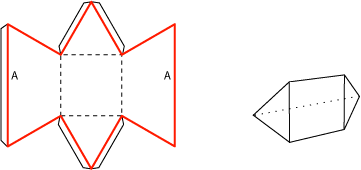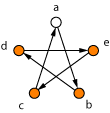Solution - Level 1
These are hints for the level one puzzles, along with occasional comments and extras. For several puzzles, there are different approaches that will also lead to a solution. Note that there may be more than one solution to some problems.
Spoke Sums
For the first puzzle, many will discover that the 7 is unimportant — that they really only have to work with the numbers from 1 to 6, and that they need to partition these six numbers into three pairs each of whose sum is the same.
Another approach is to note the sum of the numbers from 1 to 6 is 21, and so the sum of the three pairs must be 7, that is, 21 divided by 3.
For the second puzzle, the sum across each diagonal must be the same, so the sum of each pair of opposite numbers must be the same. The sum of six of the numbers must be a multiple of three, and the number 7 must be among these six numbers. All possibilities give a solution.
Another approach is to note the sum of the numbers from 1 to 6 is 21, and so the sum of the three pairs must be 7, that is, 21 divided by 3.
For the second puzzle, the sum across each diagonal must be the same, so the sum of each pair of opposite numbers must be the same. The sum of six of the numbers must be a multiple of three, and the number 7 must be among these six numbers. All possibilities give a solution.
Number Wheel
For the first wheel, the pair of numbers opposite 5 and 1 have to total 6. So the pair must be 2 and 4. This leads to two solutions.
For the second wheel, one of the numbers 2, 3, 4, or 6 has to be between the 1 and the 5. Try each of the numbers until you find the one that works.
For the second wheel, one of the numbers 2, 3, 4, or 6 has to be between the 1 and the 5. Try each of the numbers until you find the one that works.
Buggy Jump
There are many different solutions. You can make this puzzle slightly more challenging by requiring that when the bugs reach the opposite side of the board, they cannot move off that side.
Pyramid
|
A triangular pyramid (or tetrahedron) has six edges which come in three opposite pairs like the red edges in the picture on the left. One key to solving the pyramid puzzle is to recognize that the the four puzzle pieces must somehow be tilted with respect to each other, and that the two 1 × 4 pieces must lie along opposite edges.
There is a well-known puzzle related to this. To make the puzzle, cut out two pieces of cardboard in the shape shown on the left below. (All of the red edges are 1 unit except for the two long edges which are 2 units. The edges of the dotted square are also one unit in length.) Fold each piece along the dotted lines and glue the tabs to the sides to form two solid pieces each in the shape as shown on the right. Put the two pieces together to form a pyramid. |
Nine Men in a Trench
The first few moves are:
Star Jump, Circle Jump, Circle Jump II
|
For Star Jump, the last move must be to put your finger on the unshaded circle and place the fourth penny on the shaded circle marked with b. The previous (third) move must be to put your finger on the circle marked with b and place the third penny on the shaded circle marked with d.
The solutions for the other two may be obtained using a similar backtracking strategy. |
Four Cottages
We really only have to find distances of 2, 3, 4, 5, and 6, because going the opposite way will give distances of 11, 10, 9, 8, and 7. There are several solutions.
Free the Animals
Concentrate first on freeing the animals in the crowded cages.
Sam's House
The original puzzle was created by Sam Loyd in 1850 when he was nine years old. In the original puzzle there were quarreling neighbours instead of dogs, there was no grid of paving stones, and the paths were made by drawing lines with a pencil.




